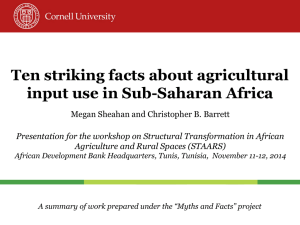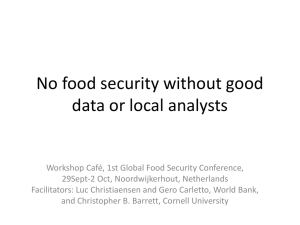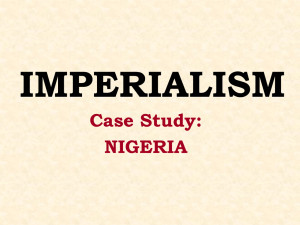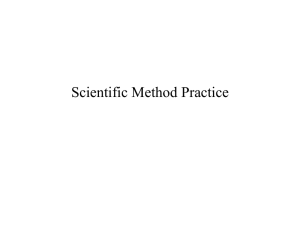Recent field, household, and community-level
advertisement
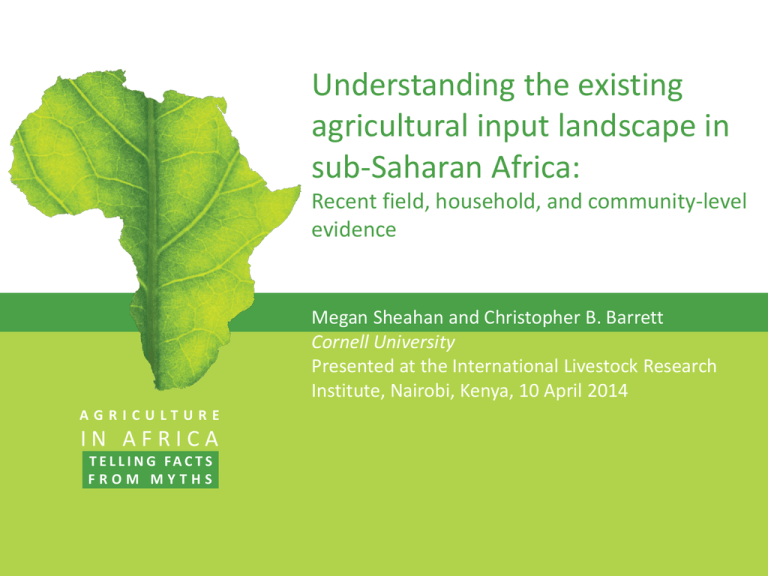
Understanding the existing agricultural input landscape in sub-Saharan Africa: Recent field, household, and community-level evidence Megan Sheahan and Christopher B. Barrett Cornell University Presented at the International Livestock Research Institute, Nairobi, Kenya, 10 April 2014 AG RICULTURE IN AFRICA T E L L I N G FA C T S FROM MYTHS Broader Motivation: LSMS-ISA data Current challenges The world in which African farmers operate has changed: • High and more volatile food price environment • Africa is growing and urbanizing quickly • Production environment changes due to climate change and soil erosion Concurrent renewed investment in agricultural sector However, knowledge base is grounded in “old ideas” about African agriculture or inappropriate data Salient case studies, purposively selected samples, agricultural statistics of unknown quality Page 2 Broader Motivation: LSMS-ISA data An opportunity! • Collecting household survey data with focus on agriculture in 8 SSA countries Burkina Faso, Ethiopia, Malawi, Mali, Niger, Nigeria, Tanzania, Uganda • Improving methodologies in data collection, producing best practice guidelines and research • Documenting and disseminating micro data for policy research • Building capacity in national institutions Page 3 Broader Motivation: LSMS-ISA data Survey features • Nationally representative (rural and urban, and various administrative levels) • 4 I’s Integrated: multi-topic and georeferenced (link with eco-systems) Individual: gender/plot Inter-temporal: panels with tracking Information technology: concurrent data entry (CAPI, GPS) • Open data access policy http://www.worldbank.org/lsms-isa Page 4 Broader Motivation: LSMS-ISA data Survey instruments Household • Individual-level data on demographics, education, health, labor & anthro • Housing, durable assets • Food & non-food consumption • Income • Food security • Non-Farm enterprises • Subjective welfare Agriculture • Plot-level data on (i) Land Areas, (ii) Labor & non-labor inputs, (iii) Crop cultivation & production • Crop sales & utilization • Farm implements • Extension services • Livestock • Fisheries Community • Demographics • Services • Facilities • Infrastructure • Governance • Organizations & groups • Market prices Page 5 Broader Motivation: LSMS-ISA data Data collection schedule for panel rounds Burkina 2014/15 Ethiopia 2011/12 Malawi 2013/14 2010/11 2013/14 Mali 2014/15 Niger 2011/12 Nigeria Tanzania Uganda 2008/09 2009/10 2014/15 2010/11 2012/13 2010/11 2012/13 2010/11 2011/12 2013/14 Page 6 Broader Motivation: LSMS-ISA data Data collection schedule for panel rounds Burkina 2014/15 Ethiopia 2011/12 Malawi 2013/14 2010/11 2013/14 Mali 2014/15 Niger 2011/12 Nigeria Tanzania Uganda 2008/09 2009/10 2014/15 2010/11 2012/13 2010/11 2012/13 2010/11 2011/12 2013/14 Page 7 Broader Motivation: “Myths and Facts” Project Project objectives • Provide a solid, updated, and bottom-up picture of Africa’s agriculture and farmers’ livelihoods • Create a harmonized and easy-to-use database of core agricultural variables for tabulation and regional cross-country benchmarking • Build a community of practice – Partnering institutions: World Bank, African Development Bank, Cornell University, Food and Agriculture Organization, Maastricht School of Management, Trento University, University of Pretoria, Yale University – Mentorship program for young African scholars AG RICULTURE from US and African institutions IN AFRICA Project led by Luc Christiaensen T E L L I N G FA C T S FROM MYTHS lchristiaensen@worldbank.org Page 8 Broader Motivation: “Myths and Facts” Project Common wisdoms revisited 1) Use of modern inputs remains dismally low 2) Land, labor and capital markets remain largely incomplete 3) Agricultural labor productivity is low 4) Land is abundant and land markets are poorly developed 5) Rural entrepreneurs largely operate in survival mode. 6) Extension services are poor 7) Agroforestry is gaining traction 8) African agriculture is intensifying 9) 10) 11) 12) 13) 14) 15) Women perform the bulk of Africa’s agricultural tasks Seasonality continues to permeate rural livelihoods Smallholder market participation remains limited Post harvest losses are large Droughts dominate Africa’s risk environment African farmers are increasingly diversifying their incomes Agricultural commercialization and diversification improves nutritional outcomes Page 9 Broader Motivation: “Myths and Facts” Project Common wisdoms revisited 1) Use of modern inputs remains dismally low Page 10 Motivation Why is it important to explore input use? • Increase in agricultural productivity necessary for agricultural transformation and poverty reduction • Expanded use of modern inputs, embodying improved technologies, is often seen as a prerequisite to increasing agricultural productivity • Common wisdoms (“stylized facts”): – African farmers use few modern inputs – Input provision systems remain poor • Those stylized facts have helped spur the new government input subsidy paradigm in SSA, although little cross-country, nationally representative, and recent evidence exists to support those stylized facts • Use LSMS-ISA data to describe “input landscape” related to fertilizer, modern seed varieties, agro-chemicals (pesticides, herbicides), irrigation, mechanized inputs (animal traction, farm machinery) Page 11 Structure of Paper Meticulously assembled data set but simple descriptive methodology • From where do common conceptions on input use currently come? – Macro-statistics: FAOStat, World Bank’s World Development Indicators, CGIAR’s Diffusion and Impact of Improved Varieties in Africa project – Micro-statistics: Literature review of studies on input use from household level data with large samples by country and input • With the newest available round of LSMS-ISA data in each country: 1. Who uses modern inputs and in what amounts? 2. What is the input provisioning situation? 3. What is the main source of variation in binary input use decision? • 10 most striking and important findings presented here Page 12 Sample and data considerations Households that cultivate at least one field in main ag season Country Year Season # hh # plots Ethiopia 2011/12 - 2,852 23,051 Malawi 2010/11 Rainy 10,086 18,598 Niger 2011/12 Rainy 2,208 6,109 Nigeria 2010/11 - 2,939 5,546 Tanzania 2010/11 Long rainy 2,372 4,794 Uganda 2010/11 First 1,934 3,349 Sample includes over 22,000 households and 62,000 plots across 6 countries Page 13 (1) Input use is not uniformly low, especially with respect to percentage of cultivating households using inputs but also rates of use. Most true of inorganic fertilizer and agro-chemical use • Near-perfect match with macro-stats on inorganic fertilizer use rates across four countries Ethiopia, Niger, Tanzania, Uganda • Largest discrepancies in 2 of 3 countries with fertilizer subsidy programs Malawi and Share of cultivating households (%) using input on fields 100 77 80 56 60 40 33 31 20 3 8 Nigeria 41 17 13 17 11 3 0 Ethiopia Malawi Niger any agro-chemical Nigeria Tanzania Uganda inorganic fertilizer • Relatively high shares of households use inorganic fertilizer, with 3 of 6 countries > 40 percent • Where > 30 percent of households use agro-chemicals, any implications for human health? • Uganda has lowest input use prevalence of 6 included countries 121 Inorganic fertilizer application (nutrients) 120 100 80 64 kg/ha 60 40 56 33 26 2523 20 2 1 6 8 7 12 13 1 2 0 Micro data (LSMS-ISA, 2009-2011) Macro data (World Bank, 2010) Page 14 (2) The incidence of irrigation and mechanization are really quite small. Micro-statistics similar to macro-statistics 10 9 9 Mechanization is proceeding slowly Water control is limited • 8 7 7 • • 6 5 5 4 4 4 1 0 4 3 3 2 4 Traction animal ownership above 20 percent in all countries except Malawi 1-2 percent of households own a tractor 1/4 of households in Nigeria used a mechanized input or animal power on their plots during main ag season 1 1 2 2 0.4 0.2 % of all cultivated land under irrigation by smallholders % of households with at least some irrigation on farm Page 15 (3) Huge amount of variation within countries in the prevalence of input use and intensity. Example from Ethiopia • Most input use appears to be driven by certain regions and zones within countries Page 16 (4) Input use is as high on maize dominated plots as it is on average at the household level. Cash crops not driving input use? Inorganic fertilizer use (kg/ha) 0 50 Ethiopia 45 100 88 135 Malawi Niger 1 146 5 123 128 Nigeria 15 16 Tanzania Uganda 150 3 1 maize plots* Households *Niger: millet/sorghum/millet/cowpea instead of maize (too few) • Commercially purchased maize seeds are used by 25-40 percent of maize cultivating households Page 17 (5) Consistent negative relationships between farm and plot sizes and input use intensity. Example from Nigeria • Local linear non-parametric regressions of unconditional inorganic fertilizer use rates • Shape differs by country, especially where ranges in size vary substantially relatively flat for Malawi and different pattern for Ethiopia and Uganda • Negative relationship is even more pronounced at the plot level in all cases except Ethiopia important policy implications! Nigeria – household level Nigeria – plot level Local polynomial smooth kg/ha of inorganic fertilizer applied to field Local polynomial smooth 200 150 100 50 0 -50 0 200 150 100 50 0 1 2 3 Total hectares of land under cultivation 95% CI lpoly smooth kernel = epanechnikov, degree = 1, bandwidth = .34, pwidth = .51 4 0 .5 1 1.5 plot size in hectares 95% CI lpoly smooth kernel = epanechnikov, degree = 1, bandwidth = .2, pwidth = .3 Page 18 (6) Little variation in input use when households and plots are split by soil quality and erosion status, both farmer-perceived and geo-referenced. Moreover, few farmers consider their plots of ‘poor’ quality • Regression analysis reveals that ‘average’ and ‘poor’ plots significantly are more likely to receive inorganic fertilizer treatments than those categorized as ‘good’ • Knowledge gap among farmers? Weak evidence against ‘poor but efficient’ claim? • Implications for extension programs and the need to invest in simple soil quality tests Page 19 (7) Surprisingly low correlation between the joint use of commonly ‘paired’ inputs. Especially apparent when moving from household to field level • Show correlation between two-way input use in paper • Can investigate three-way input use (fertilizer, seed, irrigation) for Ethiopia and Niger • Farmers may use >1 modern input on farm, but appear to be diversifying within farm rather than reaping output gains by pairing inputs together • Synergies from pairing inputs still yet to be exploited Ethiopia – household level Ethiopia – field level Page 20 (8) Fertilizer subsidies are not as universal as often believed or reported in government statistics. 3 of 6 current LSMS-ISA countries have government fertilizer subsidy programs • Mixed reviews by households on input market accessibility changes over time in Malawi, where fertilizer subsidies are most pervasive • > 50 percent of households receive a government fertilizer subsidy only in Malawi • Relatively low fertilizer subsidy occurrence in Nigeria alongside high rates of fertilizer use • Estimates of fertilizer subsidy coverage in LSMS-ISA data fall short of other estimates using government data – Could be issue of LSMS-ISA data collection timing or sluggish/failed distribution of planned vouchers by subsidy program implementers Percent of households in Malawi by perception of current input market accessibility relative to five years ago 45 39 40 35 30 29 30 25 26 22 19 20 21 14 15 10 5 0 More Less Fertilizer About the same Not applicable Improved maize seed Page 21 (9) There is very low incidence of credit use for purchasing modern inputs. Statistics should capture both informal and formal credit types • < 1 percent of cultivating households used credit to purchase improved seed varieties, inorganic fertilizer, and agro-chemicals – True of all countries except Ethiopia, where the government issues input credit • (1) Country-averaged inputoutput price ratios imply that fertilizer is a good investment at aggregate levels + (2) Wealthier households more likely to use fertilizer – No or under-use may signal cash flow constraints, which could be aided by expanding credit options • Policy implication addressing rural financial market failures may be key for expanding input use Page 22 (10) Over half of the variation in inorganic fertilizer and agro-chemical use comes from the country level. Suggests that policy and institutional environment are very important • Ultimately interested to learn where most of the variation in input use comes from – Biophysical, infrastructure, market, socioeconomic, or policy-specific variables? • Binary use at household level (avoids bias from survey design) – Also reported at field level under a number of different specifications (fewer field level characteristics match across surveys) • R2 decomposition using Shapley-Owen values • > 50 percent of variation in fertilizer use can be explained by country level! • Suggests that geography, policy, and institutional environment are important for ushering a Green Revolution in Africa Page 23 Conclusions Main take-away messages • Input use is not always low Much more heterogeneity in input use between and within countries than commonly assumed - Varies by country, input, crop, and a large number of important covariates - Micro-level statistics allow us to investigate this variation more fully • Scope for improvement remains - Synergies in effectively combining inputs appropriately yet to be exploited - Policy and institutions seem important for encouraging yield-enhancing input use • 10 findings presented here are only a small subset of what can be gleaned about input use from the LSMS-ISA surveys • Exploiting newly emerging panel data will allow us to provide greater nuance for guiding more intelligent policy design Page 24 Thank you! Contact: mbs282@cornell.edu Page 25
